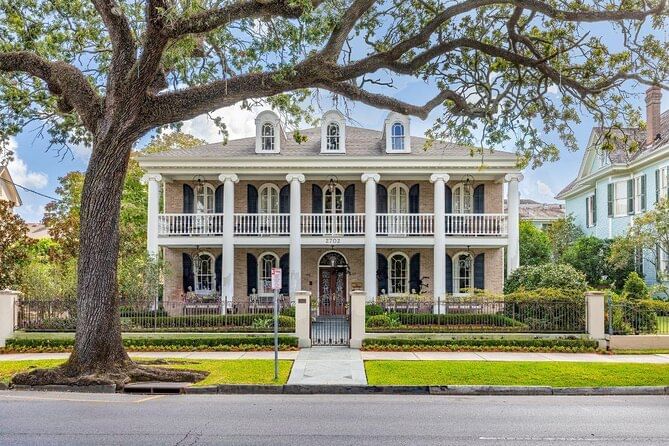
The Beauty and History of the Garden District

The Garden District sits upriver from the French Quarter, where the city once expanded into a patchwork of grand avenues, live oaks, and ornate homes that announced a new American chapter in New Orleans. The neighborhood grew as merchants and professionals sought wide lots and fresh breezes, creating a suburb that still feels like a pause button in a city famous for motion. Walking these streets today, you feel how the District’s calm answers the Quarter’s energy, telling the same story in a different voice.
How Did This Neighborhood Take Root?
The Garden District began in the nineteenth century, when English-speaking newcomers looked for space beyond the tight grid of the old city. Developers laid out generous parcels that encouraged wide lawns, deep porches, and elaborate gardens, which allowed the architecture to breathe. What you see now is the physical memory of that suburban dream, preserved in wood, brick, iron, and green canopy.
Why Is It Called the Garden District?
Early owners prized horticulture as a status symbol, turning their properties into living showrooms of crepe myrtles, camellias, magnolias, and roses. Those private botanical ambitions linked across property lines, so the streetscape began to feel like a shared park with homes tucked inside it. The name stuck because the gardens shaped the sense of place more than any one architectural style ever could.
Architectural Candy for the Patient Walker
Victorian exuberance meets Greek Revival restraint here, and both make a persuasive case for lingering. Greek Revival façades favor columns and calm symmetry, while Italianate homes tilt toward arched windows, bracketed cornices, and a flair for detail that rewards a second look. The District excels at balance, allowing lively ornamentation to play against clean lines, with every balcony and balustrade doing its part in the choreography.
How Do the Live Oaks Shape the Experience?
Live oaks stretch their limbs like open arms, knitting a high ceiling of shade that softens light and temperature in equal measure. Their roots push and weave beneath the sidewalks, reminding visitors that nature is a co-author of the neighborhood’s design. When the wind moves through those branches, the District gains a soundscape that rivals its visuals, a slow hush that sets your walking pace.
From American Sector to Timeless Treasure
In the nineteenth century, the Garden District marked an American footprint in a city anchored by Creole culture, and that contrast helped define the identity of both places. Over time, the differences blended into a shared New Orleans vocabulary of porches, shutters, ironwork, and celebration. What began as separation matured into complement, which is why visitors often pair a Quarter morning with a Garden District afternoon.
What Stories Do the Iron Fences Tell?
Ironwork in the Garden District is more than boundary and security; it is jewelry for the streets. You can read motifs like a code, spotting grapes, fleur-de-lis, acanthus leaves, and mythic creatures that speak to the owners’ tastes and the foundries’ talents. The patina of age turns black iron into charcoal satin, so even a simple fence becomes an heirloom in the sunlight.
Across from stately porches and trim hedges sits a grid of above-ground tombs that explains the practical romance of New Orleans burial traditions. The cemetery’s walls hold family histories written in marble, brick, and tile, showing how grief and memory share real estate in a climate that demands creativity. Even from the sidewalk, you sense how the living and the dead exist in conversation here, as ordinary as neighbors over a fence.
Start with proportions, because the best Garden District homes feel poised, not loud. Notice how steps lift the entrance above street level, creating a small ceremony out of every arrival. Then watch how shutters, fanlights, and porch columns guide the eye upward, where brackets and cornices finish the thought with a flourish.
One side of the Garden District gives way to Magazine Street, a river of boutiques, galleries, and sidewalk cafés that keeps the neighborhood lively without tipping it into rush. After wandering through the shaded blocks, you emerge into a stretch of small-scale storefronts that reward curiosity and conversation. The contrast between quiet residences and street-level bustle creates a perfect loop for a day on foot.
Early morning casts silver light under the oaks and allows you to hear the neighborhood wake up, while late afternoon warms the façades and invites long porch shadows. Each season adds its own accent, from spring blooms to summer cicadas, with autumn light and winter camellias rounding the year. You cannot choose incorrectly, although your camera may favor the hours when the sun skims the treetops.
The Garden District survived by a combination of sturdy construction, vigilant maintenance, and a civic commitment to preservation that turned neighbors into stewards. Elevated floors, cross-ventilation, and deep galleries solved local climate problems long before modern air systems joined the team. When storms tested the city, the District’s culture of repair and respect showed up quickly, and that habit still protects what you come to see.
Residents live inside these postcard views, so a little courtesy goes a long way toward keeping the welcome warm. Keep to sidewalks, admire from a comfortable distance, and let your photos skip the interiors that windows might tempt you to capture. A polite pace and a friendly nod preserve the neighborhood’s calm, which is part of the beauty you are here to enjoy.
What Makes the Garden District Different From the French Quarter?
The Quarter feels like a stage where every balcony wants applause, while the Garden District feels like a salon where grace speaks softly. Architecture in the Quarter huddles close and rises over narrow streets; the District spreads out, giving porches and gardens room to perform. Visitors often find that each place amplifies the other, which explains why both remain essential to the city’s identity.
Over the years, the Garden District has drawn authors, actors, musicians, and business leaders who value privacy with personality. Fame hides well behind lace iron and layered greenery, yet the presence of notable residents adds a certain sparkle to the neighborhood lore. You will hear stories of parties, projects, and passing sightings, the kind of social footnotes that make a place feel alive without turning it into a spectacle.
Directors love the District for the way it photographs, with sightlines that frame story and mood before a single line is spoken. Novelists borrow its porches and avenues to stage conversations that require elegance and shadow in equal measure. The neighborhood returns the favor by remaining itself, which is the best role any setting can play.
Begin with the foundation and roofline, because those bookends tell you how a structure meets the ground and greets the sky. Move to doors and windows, and notice their rhythm across the façade, since spacing reveals both function and fashion. Finish with ornament, which often arrived last, and imagine how brackets, railings, and plasterwork turned a fine house into a signature.
Gardenias, jasmine, and fresh-cut lawns braid the air into a gentle perfume that shifts from block to block. Wind carries a light mix of birdsong, distant conversation, and the quick hush of passing streetcars. The District invites you to match that tempo, which is why people return to walk the same streets and feel different notes each time.
New Orleans lives comfortably with mystery, and the Garden District is no exception, although its stories tend to arrive as whispers rather than shouts. You may hear about houses that refuse to forget, or corners where a certain chill lingers at noon, which says as much about imagination as it does about spirits. The neighborhood’s calm magnifies small sensations, so a creak on a stair or a flicker at a window can become an episode worth retelling.
Maps get you from block to block, yet a seasoned guide stitches architecture, biography, and social history into a narrative that makes the scenery talk. Dates gain context, names grow personalities, and design choices move from trivia to meaning as you learn why a bracket matters or how a family shaped a street. A good guide equips you to return on your own and see twice as much, which feels like finding a hidden key in your pocket.
Magazine Street Treats Without Losing the Thread
After deep dives into column capitals and cornice brackets, the pull of iced coffee or a late lunch becomes irresistible, and Magazine Street delivers without breaking the spell. Patios and counters along the corridor allow you to keep the oaks in sight while you compare notes or mark favorite façades on a map. The transition from quiet lanes to lively storefronts refreshes the senses, then sends you back for one more block of wonder.
Landscaping in the District rarely overwhelms the house; it frames it like a careful mat around a painting. Low hedges and layered plantings draw the eye along walkways, creating a prelude to the main entrance rather than a contest with it. Seasonal color punctuates evergreen structure, so the view pleases in January and dazzles in June.
Choose angles that celebrate porches and rooflines without pointing directly into private interiors, which protects both your neighbors and your composition. Natural light is your best friend under the oaks, where open shade saves details from harsh contrast and allows colors to read correctly. Step back, include a fence or branch in the frame, and you will capture depth that feels true to the District’s embrace.
The St. Charles line glides near the District, adding the soft clang of a bell and a ribbon of green cars to the neighborhood’s rhythm. That daily passage offers a reminder that the city remains in motion even where the blocks feel preserved. Riding a short stretch before or after your walk turns logistics into a small ceremony, equal parts transit and time travel.
Neighborhood organizations and dedicated homeowners treat paint, plaster, and masonry as living responsibilities rather than nostalgic burdens. Craftspeople pass down techniques that respect old materials, which keeps repairs from erasing the very qualities that make the District special. The result is a place that wears its years with health rather than fragility, inviting admiration without requiring a museum rope.
You expect elegance and find it quickly, yet the pleasure of the District comes from the many ways elegance expresses itself block by block. Some houses whisper with perfect proportion, while others sing with color and carved detail, and the alternation keeps your curiosity awake. Surprise grows from variety, and variety flourishes where time has allowed good ideas to gather.
Begin with a loop that includes Prytania, Coliseum, and First or Second Street, because those names alone hint at history layered on geography. Choose three or four houses to study closely, then give yourself permission to drift toward whatever porch or canopy catches your eye. End near a small park or a quiet corner, where you can replay the scenes and notice how the pieces connect.
Dogs tugging their humans, a child learning to ride a bike, a neighbor chatting over a gate, and a delivery cyclist ringing a gentle bell all feel perfectly at home here. The District’s grandeur never squeezes out ordinary scenes; it frames them, turning daily routines into little vignettes worth a smile. Those moments explain why the neighborhood feels welcoming rather than staged.
What Should You Wear and Bring?
Comfortable shoes make the difference between a short stroll and a satisfying wander, and a light bottle of water keeps you in the game when the sun leans warm. A small hat or parasol fits the mood and saves your shoulders, while a simple notebook helps you remember the house that surprised you at the corner. Travel light and leave hands free for photos, waves, and pointing at ironwork that steals your breath.
Ready To See the Garden District With New Eyes?
French Quarter Phantoms loves showing visitors how beauty and history meet under these oaks, because the Garden District rewards attention with stories you can still feel in your bones. Join a walk that moves at a neighborly pace, where porches become characters and gardens become chapters, and where the past speaks clearly without raising its voice. Bring your curiosity, lace up your shoes, and let a local guide help you see how a neighborhood becomes a legend, one careful detail at a time.



